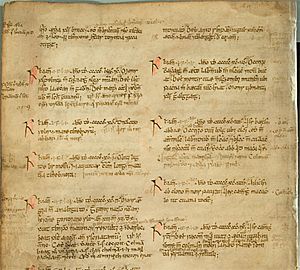Annals of Ulster facts for kids
| Original title | (Irish: Annála Uladh) |
|---|---|
| Country | Ireland |
| Subject | Medieval Ireland |
The Annals of Ulster (Irish: Annála Uladh) are like a very old diary or history book from medieval Ireland. They record events that happened between the years 431 AD and 1540 AD.
Most of these records, up to 1489 AD, were put together by a writer named Ruaidhrí Ó Luinín. He worked for a leader called Cathal Óg Mac Maghnusa. They were on an island called Senadh-Mic-Maghnusa, which is now known as Belle Isle, near Lisbellaw in Fermanagh. Other people added entries up to 1540 AD later on.
The earliest entries, up to the mid-6th century, were copied from even older books. But the later entries were written down as events happened. They were based on what people remembered or what was told through stories.
The Annals were written mostly in the Irish language, but some parts are in Latin. Because the original words were copied exactly, these Annals are helpful for historians. They also help language experts study how the Irish language changed over time.
Later, the Annals of Ulster became a very important source for other historical books. One example is the Annals of the Four Masters. It also helped create the Irish text Cogad Gáedel re Gallaib.
The original book is kept safe at the Library of Trinity College, Dublin. There is also a copy at the Bodleian Library in Oxford. This copy helps fill in any missing parts from the original. Today, you can read the Annals of Ulster in English thanks to modern translations.
What the Annals Tell Us
The Annals of Ulster are full of interesting information about medieval Ireland. They describe the lives of kings, important places, and even the arrival of the Vikings.
Kings and Leaders
The Annals often follow the lives of important kings. They mention their big battles, raids, and when they died. For example, the book tells us about Máel Sechnaill mac Máele Ruanaid, who was a powerful king from 846 to 862.
The Annals mention many events in his life:
- He is first mentioned in 839, having killed someone.
- In 845, he killed his own brother.
- He took a Viking leader named Tuirgéis prisoner.
- He defeated Vikings in a battle at Forach in 848.
- He led armies and attended important meetings.
- When he died in 862, the Annals called him "king of all Ireland."
Another king, Aed mac Neill, is also mentioned many times. His story ends with a poem about his death in 879. This poem describes him as a "generous prudent man" and a "wonderful person."
The Annals also follow the lives of Viking kings who ruled in Dublin. For example, Amlaíb Conung (also known as Olaf Konung) appears in many entries. The book even tells us about the death of his son, Oistín, who was killed by someone named Albann.
Important Places
The Annals of Ulster also focus on important places in Ireland. Armagh, which was the main church city, is mentioned many times.
Dublin is another key place in the Annals. It is called either Áth Cliath or Duiblinn in the text. The Annals describe how the Vikings first settled in Dublin. For example, an entry from 842 says, "The heathens still at Duiblinn."
Later entries show how Dublin changed. They mention important people dying there, and even times when the Irish ruled the city. For instance, in 1000, it says, "The foreigners returned to Áth Cliath and gave hostages to Brian."
Vikings in Ireland
The Annals of Ulster give us a lot of information about the Vikings invading Ireland. These events are also mentioned in other Irish books, like the Cogad Gáedel re Gallaib.
The Annals first mention the Vikings in 794. This was just one year after the famous Viking raid on Lindisfarne in England. At first, the entries are short, like "Devastation of all the islands of Britain by heathens." But over time, the attacks become more specific. For example, "807.8 The heathens burned Inis Muiredaig and invade Ros Comáin."
The Vikings are called by different names in the Annals. These include "foreigners," "dark or fair-foreigners," "heathens," "Norsemen," and "Danes." It's sometimes hard to tell if these names mean different nationalities or just different groups of allies.
The Annals show that the Vikings first came to Ireland to raid and take slaves. An entry from 821 says, "Étar was plundered by the heathens, and they carried off a great number of women into captivity." However, the Vikings eventually built a permanent base in Dublin by 841.
Even though the Vikings are often called "heathens," the Annals also show that Irish groups sometimes fought among themselves. The Vikings were even allies with some Irish groups against other Irish groups. The Annals also mention that some Irish people raided just like the Vikings.
Many famous battles and Viking leaders are mentioned in the Annals of Ulster. These include the Battle of Brunanburh in 937, the Battle of Tara in 980, and the famous Battle of Clontarf in 1014. Important Viking leaders like Turgeis, Ímar, and Amlaíb are also in the book. Famous Irish leaders like Máel Sechnaill, Muirchertach son of Niall, and Brian Boru also appear.
See also
- Irish annals
- Chronicle of Ireland


